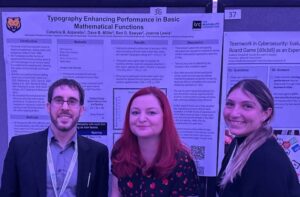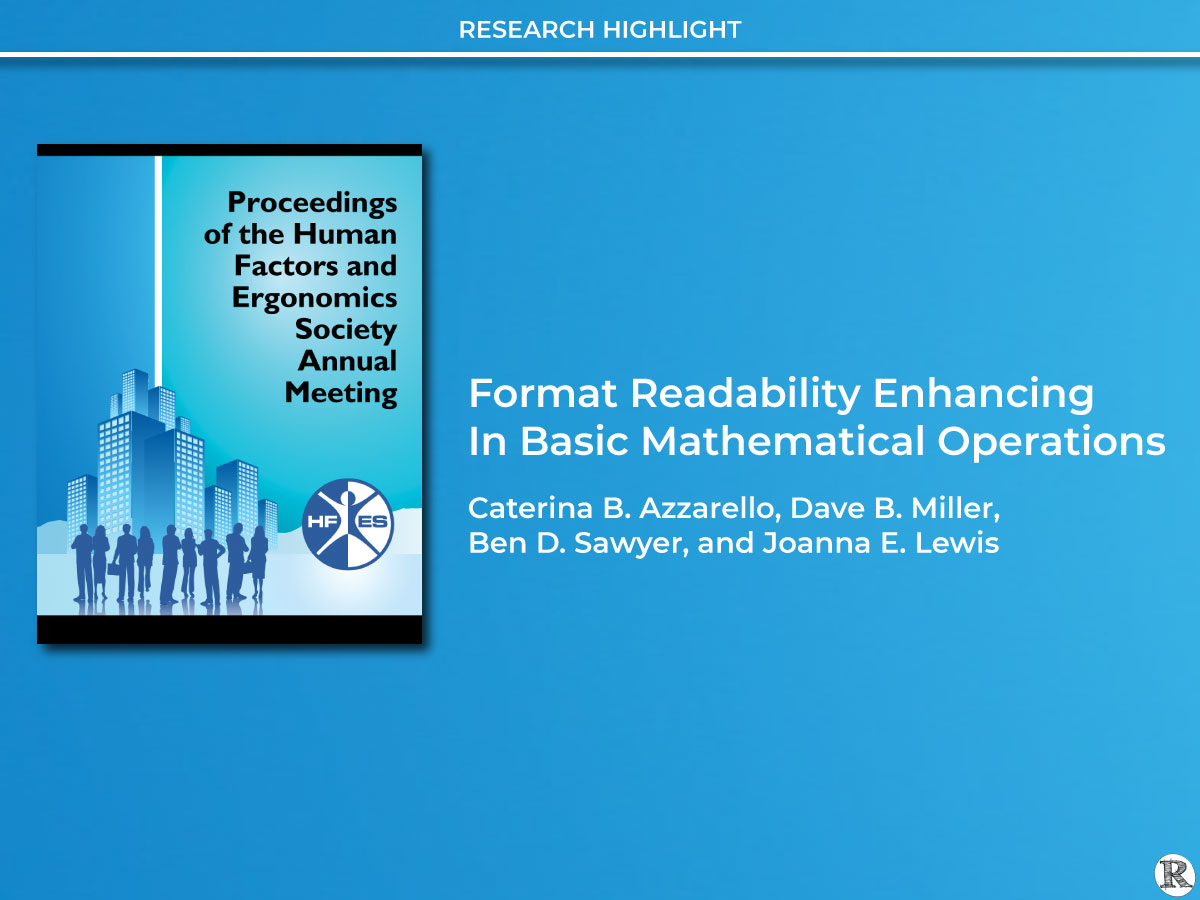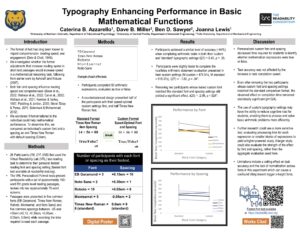Optimized Text Formats Increase Student Performance in Mathematics
Would you solve mathematical problems more efficiently or experience them as less difficult if the problems were presented in your best reading format? A new paper says yes. Recent research on how typography impacts mathematics was presented at the Human Factors and Ergonomics Society annual conference.
The team investigated whether a text format could be optimized to enhance an individual’s performance while completing mathematical tasks. To achieve this, the university-aged participants underwent a reading test on the online readability assessment, the Virtual Readability Lab. The VRL evaluated the impact of changes to font and character spacing on the student’s reading speed. The test results were used to determine the most suitable text format for each participant. Participants were then asked to complete 80 mathematical problems presented in their best text format.
Results and Discussion
The team found an individuated text format increased student performance in a basic arithmetic task, significantly reducing their total task completion time. And importantly, the task accuracy was not affected by the increase in task completion speed.
The paper discussed that “the use of custom typography settings may have the ability to reduce cognitive load for students, enabling them to process and solve basic arithmetic problems more efficiently.” Interestingly, they also noted, “It could be hypothesized that reduced readability increases perceived difficulty. As perceived difficulty of math problems increases because of reduced readability, participants may spend more time during a break or while solving a single problem, which can be disambiguated by timing individual responses.”
The research results indicate that individuated text formats, assessed for font and character spacing impact, can improve mathematics reading. This finding suggests that format readability may be important in non-traditional reading domains and have applications well beyond text reading.

Dave Miller, Joanna Lewis, and Caterina Azzarello at the annual Human Factors and Ergonomics Society meeting.
The Paper
Format Readability Enhancing in Basic Mathematical Operations
Caterina B Azzarello, Dave B Miller, Ben D Sawyer, Joanna E Lewis
ABSTRACT
Individuated font selection, which can increase text reading speed, may be able to increase mathematical expression reading speed and influence reasoning accuracy. To investigate whether the same font that increases a participant’s reading speed enhances mathematical reading, we compared their speed in evaluating mathematical expressions as true or false presented in their fastest reading font as determined by empirical test and with a control font, Times Roman. Participants were faster in completing mathematical problems when using typography selected for individual readability, but no difference occurred in task accuracy, matching patterns previously seen in interlude reading. Future research should assess the impact of elements of time pressure, math complexity, numeric versus text-based questions, and associated math anxiety.
Azzarello, C. B., Miller, D. B., Sawyer, B. D., & Lewis, J. E. (2023). Format Readability Enhancing In Basic Mathematical Operations. Proceedings of the Human Factors and Ergonomics Society Annual Meeting, 21695067231199682. https://doi.org/10.1177/21695067231199682
Read the paper here.
The Poster
Typography Enhancing Performance in Basic Mathematical Functions
Caterina B. Azzarello, Dave B. Miller, Ben D. Sawyer, Joanna Lewis
About Caterina Azzarello: Caterina has an M.A. in educational psychology from the University of Northern Colorado, where she is currently studying for her doctoral program. Currently, she is working full-time as a graduate student researcher for a few different labs. Her main topics of study are focused on human factors (i.e., eye tracking, readability), cognitive science (i.e., self-efficacy, math anxiety), and DEI-based research methods (i.e., Critical Race Theory, demographic reviews). Recent publications have focused on the interconnection between self-efficacy and mathematics and qualitative-based research methods.
About Dave Miller, PhD: Dave earned his doctorate in communication research from Stanford University, where he studied human-computer moral conflict and the human factors challenges of interaction with partially-automated systems. Subsequently he taught at Cornell University and led research focused on enhancing reading performance at the University of Central Florida. Prior to this, he studied persuasive interface design at New York University, earning a master’s degree from the Gallatin School of Individualized Study, and worked with the Persuasive Technology Lab and the Center for Design Research at Stanford University. He holds a bachelor’s degree in human-environment relations with a minor in psychology from Cornell University, and has worked in human factors consulting on projects as diverse as revising the design of Disney character suits and character actor choreography to reduce injury risk, optimizing baggage handling operations, collaborating on the design of barcode scanners, and enhancing hospital infection control procedures.
About Ben D. Sawyer, PhD: Ben is Director of The Readability Consortium and The Virtual Readability Laboratory, where he leads teams rethinking how information flows from human to machine, and back. He is Faculty at UCF in the Department of Industrial Engineering and Management Systems within the College of Computer Engineering and Computer Science, and The Institute for Simulation and Training. His previous positions include MIT’s Center for Transportation and Logistics, and Air Force Research Laboratory 711th Human Performance Wing.
About Joanna Lewis, PhD: Joanna is an assistant professor at the University of Northern Colorado. She received her Psychology Ph.D. in 2018 from the University of Central Florida as an NSF GRFP fellow. Her work focuses on the blending of interdisciplinary topics regarding visual attention, anxiety, distraction from technology, usability, cybersecurity, and education.
Dr. Lewis has focused on translating the benefits of individualized typography to new contexts, specifically to mathematical operations. Additional work explores the potential positive outcomes of applying typography recommendations within the classroom to improve digital literacy, particularly for first generation students.
About HFES: The Human Factors and Ergonomics Society, founded in 1957, is the world’s largest scientific association for human factors/ergonomics professionals. HFES provides education, builds connections, and advocates on behalf of human factors/ergonomics field—from students to researchers, and industry practitioners—and fosters collaboration across the spectrum of professionals to drive forward advances in human factors and ergonomics because HFES believes that the seamless connection between humans and systems, and the connection between research and application, is vital to keeping all human beings safe.





